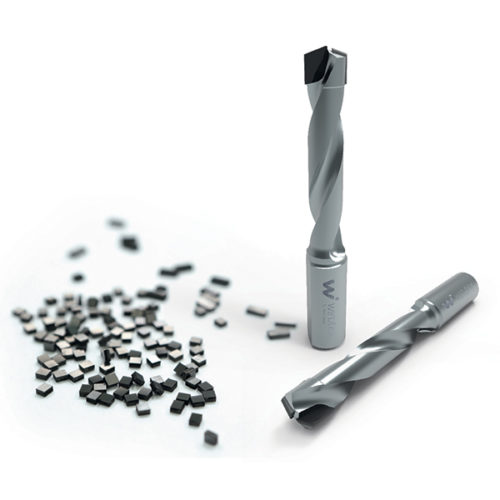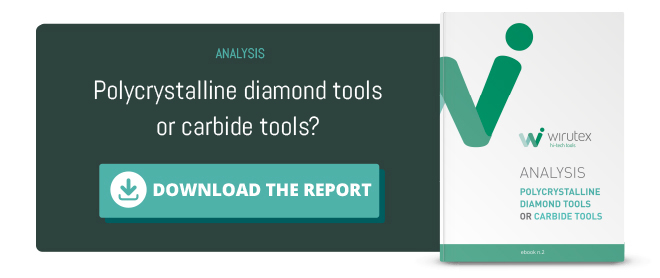Polycrystalline diamond tools excel in
durability, performance and quality

Polycrystalline diamond tools comprise cutting tools with diamond grains brazed onto the functional parts of the tool by means of an adhesive material or another similar method. Since diamond is an extremely hard and resistant material, diamond tools provide many clear advantages compared to other tools made with common materials such as cemented carbide or tungsten carbide.
What is polycrystalline diamond?
Polycrystalline diamond (PCD) is a synthetic diamond produced in the laboratory through a sintering process. It is an extremely resistant material where randomly oriented diamond crystals are bonded to a sub-stratum of tungsten carbide.
During the sintering process, the empty spaces between the PCD grains are filled with a cobalt alloy. Unlike cemented carbide however, the single diamond grains bond to each other. The result is an extremely hard product that keeps its shape and strength, even if a part of the metal matrix is removed.
Diamond is the hardest material in nature and thus the most resistant to abrasion. In some cases, the properties of synthetic diamonds may be superior to those of natural diamonds: hardness, thermal conductibility and electron mobility are indeed greater in some synthetic diamonds.
The hardness of polycrystalline diamond makes it an excellent cutting material and ideal for use in cutting tools. It also contributes to the diamond tool having a longer cutting lifetime.
Polycrystalline diamond reacts to elements such as iron and cobalt that cause tool deterioration. For this reason, PCD is mainly used for the tooling of non-ferrous materials like wood, aluminium and aluminium alloys.
What are the various applications of polycrystalline diamond?
Polycrystalline diamond has an excellent cutting quality and great wear resistance, but that is not all: another characteristic of this material is its exceptional tenacity, which enables its use in unstable situations.
As mentioned previously, PCD combines:
- Hardness
- Resistance to abrasion
- Toughness
- Tenacity
- High heat conductivity
Thus, PCD is mainly applied to processing non-ferrous materials, comprising aluminium alloys, carbon fibre, ceramic, graphite, plastics, rubber, wood, polycarbonate, copper, titanium and platinum.
In addition to these, polycrystalline diamond can be used in several other applications that require precision and wear resistance.
All the advantages of this extremely hard, abrasion-proof cutting material are exploited to the full in the production of tools such as precision counterbores and precision reamers, turning and milling tools and inserts.
In brief, polycrystalline diamond is ideal for machining:
- Tungsten Carbide
- Aluminium and alloys
- Graphite
- Carbon Fibre
- Glass Fibre
- Ceramics
- Chipboard
- MDF / HDF
- Laminate floors
- Copper Alloys

The quality of polycrystalline diamond
PCD comes in various qualities. Most applications for machines are provided a standard quality with variable grain size. The most demanding applications can be provided with a larger grain size or with a “polished” tip. Polished PCD helps to prevent the accumulation of materials on the cutting edge. This, together with the lower heat generation when machining, translates into improved tool performance.
Why is PCD recommended for machining wood?
As explained earlier, polycrystalline diamond (PCD) is an extremely resistant, high performance synthetic material. Owing to its hardness, resistance to abrasion, heat conductibility, and many other exceptional properties, PCD is widely used in many industries, including the furniture sector where it is used for machining chipboard, laminated materials, MDF, HDF, PVC and CORIAN.
As the global population grows, consumption of wooden materials is increasing considerably.
The application of PCD to the wood machining industry has both benefited the industry and extended the range of PCD applications.
Several studies have demonstrated that the excellent cutting performance of PCD tools will result in an increasingly broader range of applications in the wood machining industry over the course of the 21st century.
Today’s technologies and wood machining operations require precision and durability, which has led to a rise in popularity for polycrystalline diamond tools in recent years.
PCD cutting tools offer utmost precision in achieving the highest finishing standards for the end product, and their wear resistance guarantees a longer cutting lifetime compared to traditional tools with cutting edges in tungsten carbide, since they reduce production costs to a minimum and optimise performance and quality.
The advantages of polycrystalline diamond tools
The inherent properties of PCD and the data that emerge from the application of PCD tools on non-ferrous materials have shown an increase in production quality and efficiency, and therefore in performance.
PCD tools are being used more and more in high-volume wood-compound machining given their superior lifetime and the cost savings generated by reducing machinery downtime when tools are changed.
What are the main advantages of using PCD tools?
Here is a list of the main advantages:
- High speed processing
- High wear resistance
- Reduced machine downtime to change tools: less machine downtime means lower production costs
- Long lifetime: this can increase work efficiency significantly
- Consistent product quality in terms of finishing grade
- Reduced production costs
Wirutex hi-tech tools and the quality of its products
Polycrystalline diamond has been used in the wood industry for many years due to its hardness and resistance to abrasion.
Wirutex has made PCD tools since the 1980s. Our products are founded on the expertise and experience we have gained over the years in the wood machining industry.
The use of latest generation technology and in-depth knowledge of the market and materials have led to Wirutex keeping focused on innovation and producing polycrystalline diamond tools that meet the specific needs of customers.
Each stage of the industrial process, from the initial project to the end product, undergoes rigorous, detailed checks to guarantee functionality, safety and high performance. This system is extended to all of the services, enabling us to continuously raise the bar and carry out new experiments.
The key players in this wave of cutting-edge advancements are without a doubt companies like Wirutex that have the necessary technologies and skills, and that have invested in new, modern machinery for years, creating state-of-the-art production processes.

